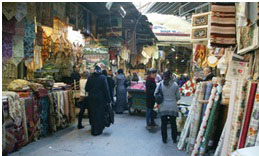DAMASCUS, (ST) – Markets of old Damascus attract visitors from all over Syria and the neighboring countries. A tour of those markets summarizes to visitors the landmarks of the city, its ancient heritage, and its original stockpile of heritage and modern industries that have become well -known across the whole world. The city of Damascus has enveloped those markets with much splendor, where everyone gets a lot of enjoyment in shopping under their covered roofs that protect the visitors from heat in summer and cold in winter.
Those markets, that branch off from the Hamidiyah famous Market, include Al -Qishani (porcelain) Market, Al – Arayes (prides)Market and Al –Harir (silk) Market in addition to the Jewelry Market and Cosmetic Products Market, adjacent to the Umayyad Mosque. The markets are famous for archaeological Khans.
A dealer in Al –Harir Market, Mohammed Al -Sabbagh, says that the age of this market is about one hundred year and it is dedicated to sell silk, yarns, supplies of sewing, beads, embroideries, towels, blankets, supplies of hairdressing, makeup, accessories of all kinds and supplies of brides.
In the shop of Mr. Al –Sabbagh, the prides and women can find everything they need of beautiful cases for sewing and its supplies such as needles, brightly colored yarns, beautiful buttons and tulle. Mr. Al –Sabbagh talks in a lovely way about his profession without having tired or being bored of repeating the question about the things that the customer wants to buy. If the customer does not buy, he doesn’t feel angry or upset, but he says farewell to his customers with the same smile he received them.
Fatima, a customer, says that her visit to these markets is one of her main enjoyments and she sometimes buys things that she does not plan to buy in advance, but she has great admiration when she sees them, she cannot resist the charm of their acquisition.
These markets constitute a varied museum where you can find whatever you would imagine. The acceptable prices, the warm welcome, gentle treatment and good reputation of dealers, which reflect the good morals of those people in general, attract customers to bear difficulty and go shopping across the old alleys.
These markets are integrated and harmonious. The visitors, in the presence of history and archaeological places, move from one shop to another without getting tired or bored.
Ghada, a customer, admires the beauty of the market and the way of presenting goods, but the only thing that she takes into account is to have enough money to buy anything she likes.
What draws attention in these traditional markets are handmade works, embroideries made by Syrian hands especially ladies who work at homes and take these things to the market to promote or to purchase supplies of work such as tulle, beads and lace. The markets, to this day, attract especially brides who are keen on acquiring, such things, as a historic legacy that abbreviates the history of mothers and grandmothers.
At al -Qeishani (faience) Market, the hearts of girls beat strongly when they choose evening and wedding dresses with a group of women from the relatives or their friends who walk around with them. Sometimes, they choose what fit them and joy fill their faces when they finish the task. You have many choices and the goods are varied and suit all tastes as the sewing option is very easy and simple whereas the fabric and cloth are available in addition to expert hands.
There is no doubt that the ancient historical markets of Damascus are an integral part of the authenticity and originality of the city. The markets are varied and their names depend on the type of goods they sell like Al –Bzouriyeh (nuts and seeds) Market, Al –Asroniyeh (cooking utensils) Market, Al –Khayatin (tailors) Market, Medhat Pasha Market located near Bab Al -Jabyeh area, Al –Niswan (women) Market, Cotton Market, Wool Market and others.
It is worthy mention that the old City of Damascus has 55 old markets still exist to this day, 25 of them are covered with metal sheets or stone arches.
Sharif al –Khatib

